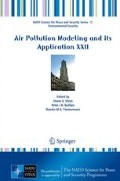Abstract
The impact of aerosol radiation absorption on the heat budget and the dynamics of the PBL has been investigated using a Large Eddy Simulation model.
Access this chapter
Tax calculation will be finalised at checkout
Purchases are for personal use only
References
Yu H, Liu SC, Dickson RE (2002) Radiative effects of aerosols on the evolution of the evolution of the atmospheric boundary layer. J Geophys Res 107(D12). doi:10.1029/2001JD000754
Gao RS et al (2008) Calculations of solar shortwave heating rates due to black carbon and ozone absorption using in situ measurements. J Geophys Res 113(D14203). doi:10.1029/2007JD009358
Madronich S (1987) Photodissociation in the atmosphere: actinic flux and effects of ground reflections and clouds. J Geophys Res 92(D8):9740–9752
Bierwirth E et al (2010) A new method to retrieve the aerosol absorption coefficient from airborne flux density and actinic radiation measurements. J Geophys Res 115(D14211). doi:10.1029/2009JD013636
Angevine WM, Grimsdell AW, McKeen SA, Warnock JM (1998) Entrainment results from the Flatland boundary layer experiments. J Geophys Res 103(12):13689–13701
Raga GB, Castro T, Baumgardner D (2001) The impact of megacity pollution on local climate and implications for the regional environment; Mexico city. Atmos Environ 35:1805–1811
Author information
Authors and Affiliations
Corresponding author
Editor information
Editors and Affiliations
Additional information
Questions and Answers
Questioner Name: Yosef Levitin
Q: What source of surface heat flux of 100 Wm−2?
A: We prescribe during the whole simulation in both mixed-layer and large-eddy simulation models a constant surface sensible heat flux (SH) of 0.1 mKs−1 for the REF experiment. For UNI and TOP the SH is reduced to 0.08 mKs−1 due to the aerosol shadowing at the surface.
Q: Do you use different models for rural and urban areas?
A: We do not have land-use or surface heterogeneity. We consider a flat and homogeneous surface for all the experiments with a constant and prescribed surface sensible heat flux.
Questioner Name: Peter Buitjes
Q: Is there an explanation why the uniform case height of the ABL goes faster to equilibrium than the aerosol-cases?
A: Since the aerosols initial condition in the UNI is already uniformly distributed in the mixed-layer, the equilibrium is reached around 2 h before than the TOP experiment. In addition, the aerosol layer in the TOP experiment disturbs more the inversion layer jump (Fig. 19.2b) and as a consequence additional time is needed to reach a new equilibrium state.
Rights and permissions
Copyright information
© 2014 Springer Science+Business Media Dordrecht
About this paper
Cite this paper
Barbaro, E.W., de Arellano, J.VG., Krol, M.C., Holtslag, A.A.M. (2014). Impact of Aerosol Radiation Absorption on the Heat Budget and Dynamics of the Atmospheric Boundary Layer. In: Steyn, D., Builtjes, P., Timmermans, R. (eds) Air Pollution Modeling and its Application XXII. NATO Science for Peace and Security Series C: Environmental Security. Springer, Dordrecht. https://doi.org/10.1007/978-94-007-5577-2_19
Download citation
DOI: https://doi.org/10.1007/978-94-007-5577-2_19
Published:
Publisher Name: Springer, Dordrecht
Print ISBN: 978-94-007-5576-5
Online ISBN: 978-94-007-5577-2
eBook Packages: Earth and Environmental ScienceEarth and Environmental Science (R0)

